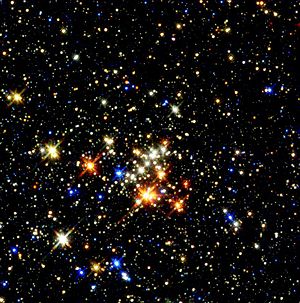WR 102ea
| Observation data Epoch J2000 Equinox J2000 | |
|---|---|
| Constellation | Sagittarius |
| Right ascension | 17h 46m 15.12s[1] |
| Declination | −28° 49′ 36.9″[1] |
| Characteristics | |
| Evolutionary stage | Wolf Rayet
|
| Spectral type | WN9h[2] |
| Apparent magnitude (K) | 8.8[3] |
| Details | |
Myr | |
| Other designations | |
FMM 241, qF 241, (erroneously QPM-241), Q10, MGM 5-10, LHO 71 | |
| Database references | |
| SIMBAD | data |
WR 102ea is a
infra-red
wavelengths due to the dimming effect of intervening dust on visual light.
It is an evolved massive star which has an emission line spectrum from a strong stellar wind caused by high luminosity and the presence of elements heavier than hydrogen in the photosphere. The spectrum is dominated by ionised helium and nitrogen lines due to convectional and rotational mixing of fusion products to the surface of the star. However it is still in a core hydrogen burning phase and hydrogen lines are also visible in the spectrum, in contrast to WN stars without hydrogen which are older, less massive, and less luminous. Despite being a relatively unevolved star, WR 102ea has lost over half its mass already.[5]
References
- ^ S2CID 11060463.
- ^ S2CID 30091594.
- S2CID 260300.
- S2CID 260300.
- ^ Bibcode:2011BSRSL..80..160L.

